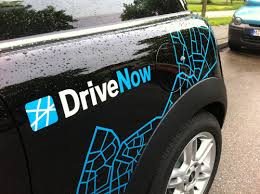DriveNow – A very local network

DriveNow, is a freefloat-carsharing offering by BMW and Sixt.
What is DriveNow?
DiveNow is a carsharing offering by the German Car manufacturer BMW and the rental car company Sixt. In this cooperation, BMW is providing the cars (all BMWs) and Sixt is covering the logistics part of the business. The project started in June 2011 in Munich and has by now expanded to Berlin, Düsseldorf, Cologne, Hamburg, Vienna, London, Copenhagen and San Francsico.
The service was started in June 2011 with 300 cars in Munich.
In contrast to a typical car rental, where cars are rented a specific location and returned after a few days, Carsharing allows using cars that are parked anywhere in the city for a short period of time. Costs are mostly calculated per minute (e.g. starting at 24 Cents in Germany) and include gasoline etc. The return can occur anywhere in the same city (with some excetions). It is a full pay-per-use model, with no subscription based fixed costs (except a one-time registration fee of €29).
Getting a DriveNow car is a two-step process. First, the driver has to search for a DriveNow Car closed to the current location The app enables and supports the search process. At the car, the drivers license or customer card can be used to unlock the car. After entering a PIN code, customers can start driving. Opening and closing the car can also be done via the App. DriveNow has a cooperation with the cities to include the parking fee in the costs per minute, so that customers to not have to worry about parking costs.
The direct competitor of DriveNow is the Car2Go, a Mercedes-Benz subsidiary, offering the service in SMARTs. Currently, both companies have approximately the same size.
How do network effects create value?
The value of carsharing is to get rid of the high fixed costs of owning a car and the fact that the asset utilization of a private car is really low (most of the time the car is unused in the garage). Carsharing enables customers to share a car with other customers and only pay for the car, when they actually use it. The idea is that customers do not longer need a personal car.
The demand side (customers) is pretty straight forward, but conditional on a certain level of supply. If there are not enough cars in the city, the value of carsharing is very low, since customer barely find a car. The more cars are in the system, the higher the value of the service for customers. On the other hand, the more customers go on the platform, the better the utilization rates of the cars and thus the more profitable the business.
The networks in this case are highly fragmented. It is a local and asset intensive business, where having a lot of cars in Berlin, only has very limited benefits for the local market in Munich. Thus, demand has to be stimulated in every city individually, with the required supply of cars needed. Even within a city, the demand patterns have to be constantly assessed in order to optimize the business.
In some cities, the business was already shut down, since the network was not large enough and the effect did not kick in. Mercedes terminated the Car-2-Go service in Ulm for instance and announced that the customer network was not big enough in this market.
Scaling DriveNow
The fact that this business is based on a lot of different networks that are not really interrelated complicates the scaling of the business tremendously. Still, DriveNow is growing quite strongly. The market in Germany however is tough. Only a few cities have the required size to get to a large enough network and make the business profitable. Even in Berlin, the current market share of carsharing is only 0.1%, which is 10 times less than the share of cab rides.
The real potential for free-float-Carsharing is supposed to be in the really big cities.


